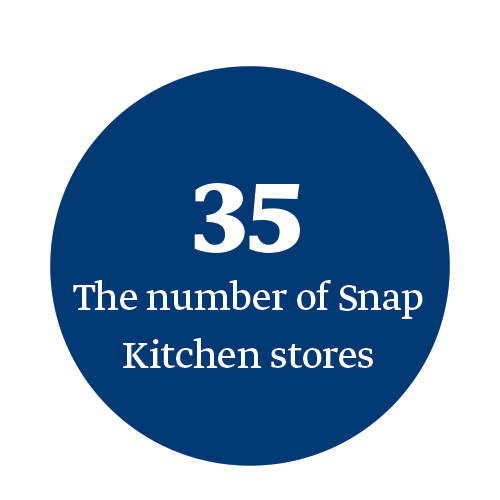On a busy street in Philadelphia lies one of the most convenient offerings of food to go in retail there is. RN visits Snap Kitchen to find out more
As convenience retail evolves and food to go expands to take up more shelf space each year, it begs the question: what is the logical conclusion of the category? Where does it end?
In a 675sq ft space in the heart of Philadelphia, Pennsylvania, is one of the best examples of the ‘foodvenience’ end game there is.
The business started in 2010 in Austin, Texas, and reached Philadelphia in 2015. Four years later, it has seven premises in and around the city and 35 in total across four US cities.
Snap Kitchen’s tagline is ‘the one-stop healthy meal shop’ and the majority of its range is dedicated to exactly that: ready meals, such as chicken and butternut macaroni, crispy salads and Thai Green bowls. Each protein source is colour coded – red for red meat, yellow for chicken, blue for fish and green for vegetarian. Customers can warm-up their meals with four in-store microwaves.
 The store does feature impulse snacks, but these, too, have that healthier twist to appeal to the city’s affluent millennials. Oat pots, dried fruit, protein bars and nuts line ambient shelves next to the store’s entrance, with lunch and dinner ready meals next, followed by a broad breakfast display. Banana pancakes, spinach and goat cheese scramble and sweet potato veggie benedict are some of the dishes that sit near each other. Then there is the range of drinks featuring kombucha and cold brew, which every store in Pennsylvania is expected to carry.
The store does feature impulse snacks, but these, too, have that healthier twist to appeal to the city’s affluent millennials. Oat pots, dried fruit, protein bars and nuts line ambient shelves next to the store’s entrance, with lunch and dinner ready meals next, followed by a broad breakfast display. Banana pancakes, spinach and goat cheese scramble and sweet potato veggie benedict are some of the dishes that sit near each other. Then there is the range of drinks featuring kombucha and cold brew, which every store in Pennsylvania is expected to carry.
Snap Kitchen’s focus on fresh, good-looking food has enabled it to cultivate a loyal following on social media. Its Instagram account boasts more than 43,000 followers and rather than hard-selling products or using it as a tool to communicate deals, it simply showcases the products and the ingredients, and teams up with bloggers to help the company reach a wider audience.
The posts tell a story about the business, its mission and its values. One of its most recent posts is about the launch of its newest initiative – compostable packaging, a crucial development for its eco-conscious consumers.
“Lunch and dinner are our busiest times, with a peak between 12pm and 1pm,” says store manager Dylan Scott. “We do think of ourselves as a convenience store, but the most popular concept we offer is our online meal-planning service.”
And this is where Snap Kitchen drives loyalty. Consumers can go online, plan their meals for the week and then get them delivered or collect in store. A chiller next to the microwaves is dedicated to this service, with bags marked with handwritten customers’ names for a personal touch.
It’s a simple approach to meal planning and nutrition. Online, customers can choose from plans such as low-carb, balance and vegetarian. They can set their calorie goal, choose meals for up to six day-parts – breakfast, lunch, dinner, AM snack, PM snack and drinks – and decide whether they want it delivered or to pick up in store.
“In store, our customers spend about $15 (£11.73), but online the average spend is $30-$45 (£23.44-£35.17). We offer tiered discounts to encourage people to let us become an integral part of their lifestyle,” explains Dylan.
Snap Kitchen’s newest range is called ‘Whole 30’, based on a diet that has swept across America since 2009. The idea behind it is simple: for 30 days, avoid added sugar, alcohol, grains, beans, dairy, MSG or baked goods, instead consuming moderate portions of meat and plenty of vegetables and natural fats.
It’s a tough programme that is branded as a ‘nutritional reset’, and it means preparation is key, but by offering these meal plans, Snap Kitchen is able to make it easy for their shoppers.
“We don’t dictate diet or preach what is healthy and what isn’t. We just make sure we offer quality. If our customers choose to eat meat, they get only the best grass-fed beef – we can make sure our customers eat well whatever their diet,” explains Dylan.



Comments
This article doesn't have any comments yet, be the first!